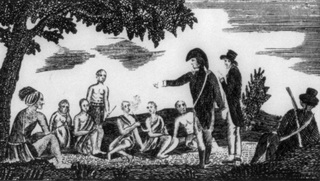 | Back to e-WV
| Back to e-WV
 The West Virginia Encyclopedia
The West Virginia Encyclopedia
 | Back to e-WV
| Back to e-WV
 The West Virginia Encyclopedia
The West Virginia Encyclopedia

In 1803, President Thomas Jefferson asked Congress to appropriate funds for an exploration of the part of the continent bordering on the Missouri and Columbia rivers. Jefferson chose Meriwether Lewis, an experienced army officer and frontiersman, to head the expedition. Captain Lewis then chose William Clark, a fellow frontier officer, to join him.
Lewis proceeded first to the U.S. government’s arsenal at Harpers Ferry, where he acquired weapons and other supplies manufactured there. The supplies were transported overland to Pittsburgh, where the party set out down the Ohio River on September 1, 1803. It took Lewis and Clark a little more than two years to reach the Pacific.
The hundred miles from Pittsburgh to Wheeling were extremely difficult because of low water and an abundance of driftwood on the Ohio River. When he finally arrived at Wheeling, Captain Lewis described it as ‘‘a pretty considerable Village of fifty houses.’’ The party rested for two days during which time Lewis met Dr. William Patterson, the owner of the largest collection of medicines west of the mountains. As he set out from Wheeling, Lewis found the Ohio broader and deeper and lined on both banks with hardwoods. Just below Wheeling, he stopped at an Indian earth mound (Grave Creek Mound in Moundsville) and described it in great detail in his journal.
The trip down the Ohio was a practice run for the rest of the trip. To determine whether the Missouri country to which they were headed could sustain a population comparable to the Ohio River country, Lewis took notes on rainfall, temperature, kinds of timber and vegetation, and farming techniques as he descended the river. When he reached the army outposts on the lower Ohio (beyond the border of present West Virginia), Captain Lewis was authorized to enlist 12 men to join the expedition. Among them was Sergeant Patrick Gass, a West Virginian whom Lewis later praised for his faithful service, diligence, and integrity. Gass’s journal, which his captain instructed him to keep, became the first published account of the expedition.
Written by Susan E. Lewis
Ambrose, Stephen E. Undaunted Courage: Meriwether Lewis, Thomas Jefferson, and the Opening of the American West. New York: Simon & Schuster, 1996.
Jackson, Donald, ed. Letters of the Lewis & Clark Expedition with Related Documents, 1783-1854. Urbana: University of Illinois Press, 1962.
Moulton, Gary, ed. The Journals of the Lewis & Clark Expedition. Lincoln: University of Nebraska Press, 1989.